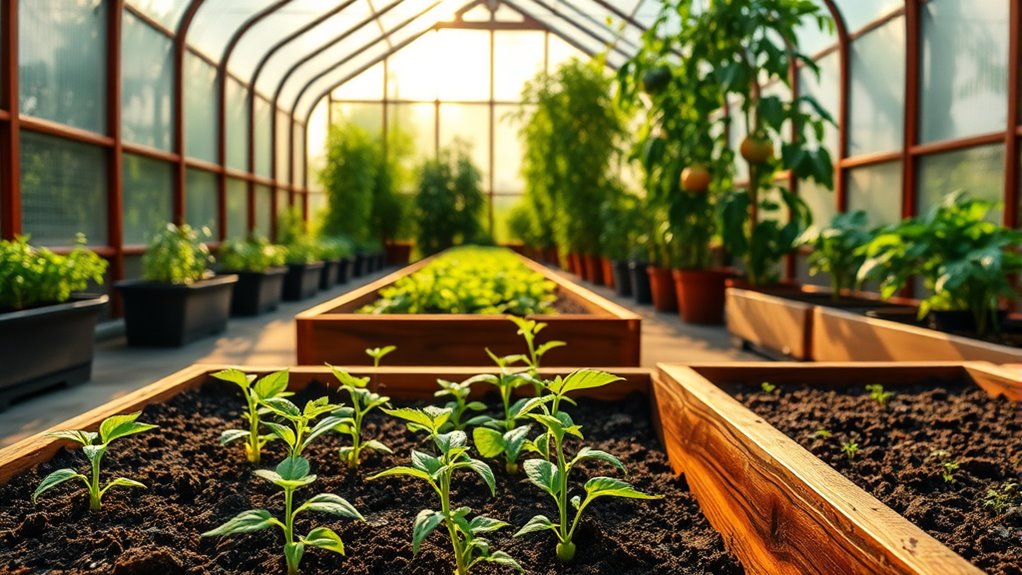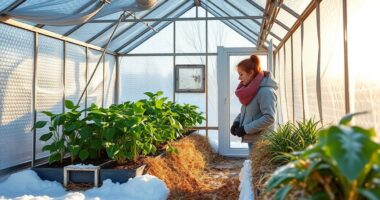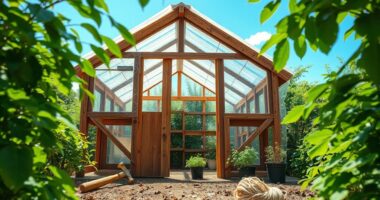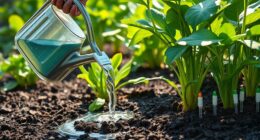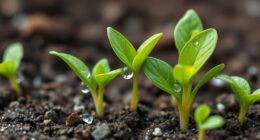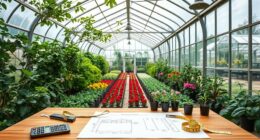Creating raised beds inside your greenhouse gives you better drainage and efficient water management, which can boost plant health. You’ll want to choose durable materials, like cedar or metal, to guarantee longevity. Design your layout with enough space for access and airflow. Fill your beds with a nutrient-rich soil mix for peak growth. Regular maintenance is key to preventing issues. Keep going to discover tips on construction and maximizing your greenhouse’s environment.
Key Takeaways
- Choose durable materials like cedar or composite for raised beds to withstand greenhouse conditions and prevent moisture damage.
- Design beds with a north-south orientation to ensure even sunlight distribution and optimal plant growth.
- Utilize a soil mix of topsoil, compost, and organic matter to provide nutrients and ensure excellent drainage within the raised beds.
- Maintain pathways between beds for easy access, ensuring widths do not exceed 2 feet for single-sided access.
- Incorporate efficient irrigation systems and monitor for pests regularly to maintain a healthy growing environment in the greenhouse.
Benefits of Raised Beds in Greenhouses
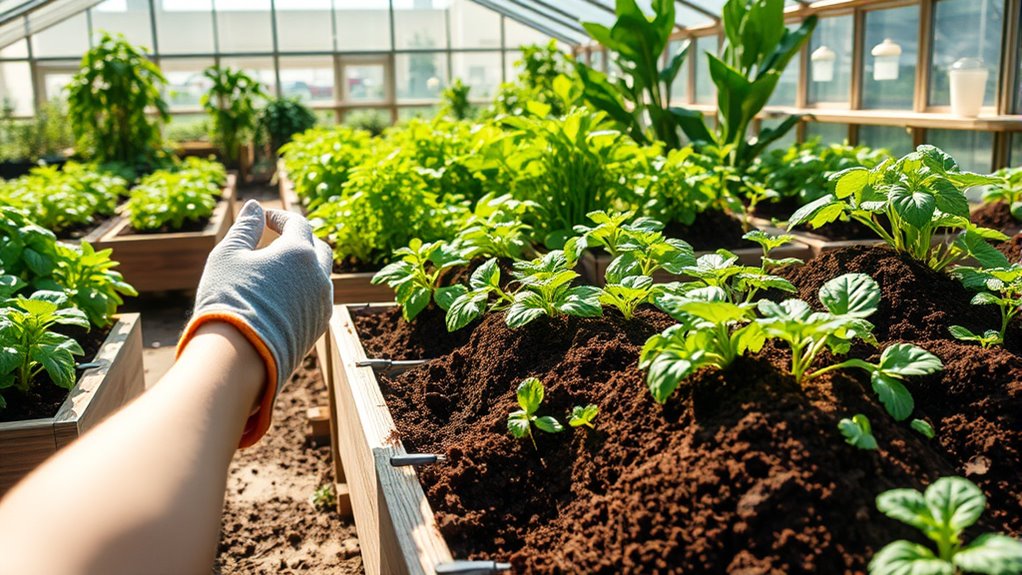
When you create raised beds in your greenhouse, you uncover numerous benefits that enhance your gardening experience.
Improved drainage is one of the key advantages, preventing waterlogged soil and root rot, which is essential for moisture-sensitive plants. You’ll also find that efficient water use guarantees your plants receive just the right amount of moisture for peak growth.
Improved drainage and efficient water use are vital for preventing root rot and ensuring optimal growth for your plants.
With reduced soil compaction, roots can grow freely, absorbing nutrients effectively. Healthier root systems lead to more robust plants.
Plus, incorporating organic matter enhances soil structure, boosting nutrient-holding capacity. This customizable soil mix allows you to tailor it for specific crops, improving overall plant health and productivity in your greenhouse. Additionally, raised beds can extend your gardening season by warming the soil faster in spring, allowing for earlier planting.
Enjoy a thriving garden with these incredible benefits!
Choosing the Right Materials for Your Raised Beds
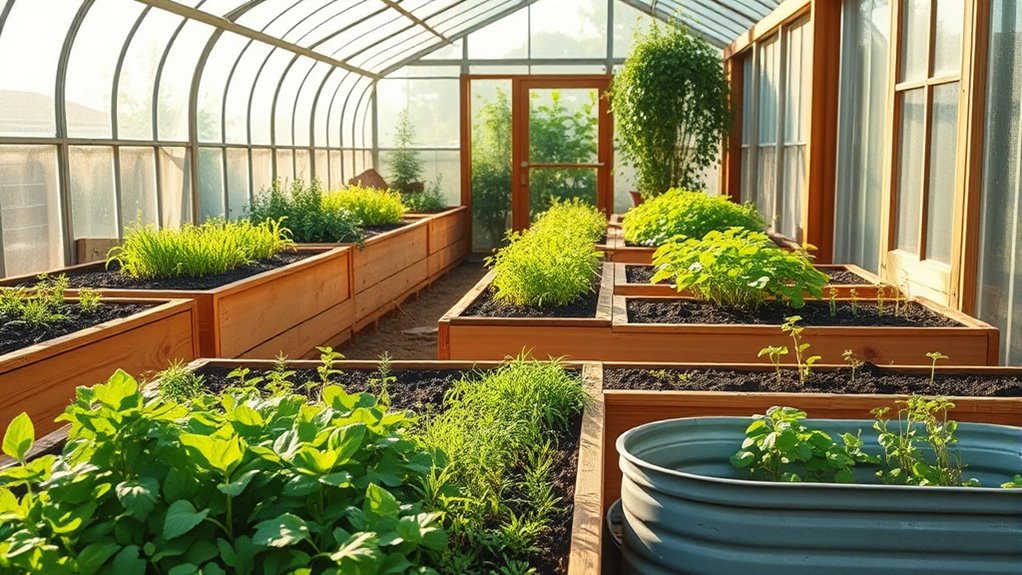
Raised beds can greatly enhance your greenhouse gardening experience, but selecting the right materials is just as important for maximizing their benefits.
Wood, particularly cedar, is a popular choice due to its natural resistance to rot and insects. If you’re looking for durability, consider metal options like corrugated steel, which require less wood and stand up to weather. Additionally, using sustainable materials can help minimize your environmental impact while maintaining structural integrity. Incorporating proper design techniques into your raised beds can also improve drainage and aeration for your plants. Selecting the right materials, like well-draining soil, is essential for preventing root rot and ensuring healthy plant growth. Eco-friendly practices when constructing raised beds can further contribute to a sustainable gardening approach.
Rock and concrete provide permanence but come with a higher price tag. For a sustainable option, recycled materials like plastic or pallets can save you money and reduce waste.
Don’t forget composite materials, which can line your beds to protect against moisture damage. Additionally, incorporating omega-3 rich seeds into your gardening can promote healthier plant growth and improve soil quality. Choose wisely to guarantee your raised beds are functional, appealing, and environmentally friendly.
Designing Your Raised Bed Layout
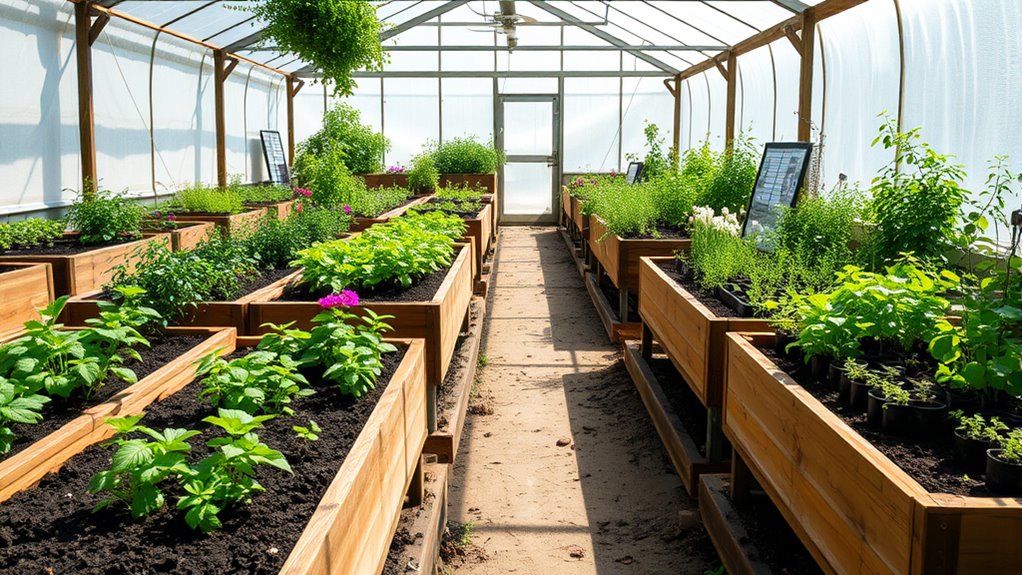
When designing your raised bed layout, think about the ideal placement to maximize sunlight and accessibility.
Consider the size and shape of your beds to guarantee they fit comfortably within your greenhouse space while allowing for easy maintenance.
Balancing these factors will help you create an efficient and productive growing environment.
Optimal Bed Placement
To create an effective raised bed layout in your greenhouse, you should prioritize ideal bed placement that maximizes sunlight exposure and accessibility.
Position your beds in a north-south orientation to guarantee even sunlight distribution throughout the day. Leave ample pathways between beds for easy access, which will help reduce soil compaction and make maintenance simpler.
Consider the height of your crops: plant taller varieties on the north side to avoid shading shorter plants. Additionally, place trellises at the northern end to optimize space.
Assure good air circulation by avoiding overcrowding and positioning beds strategically to manage humidity levels.
This thoughtful arrangement won’t only enhance plant growth but also keep pests and diseases at bay.
Size and Shape Considerations
Choosing the right size and shape for your raised beds can greatly impact both plant health and your gardening experience. Aim for a width no greater than 4 feet, allowing you to reach every part without stepping on the soil.
Length can vary, but keep it manageable; very long beds can be cumbersome. A height of 8 to 12 inches promotes better root growth, while deeper beds offer more root expansion but may need extra support.
Consider accessibility by making beds at least 24 inches tall for wheelchair users. Finally, think about your space constraints and the plants you want to grow—different crops have varying depth requirements, so tailor your beds accordingly for best results.
Constructing Durable and Functional Raised Beds
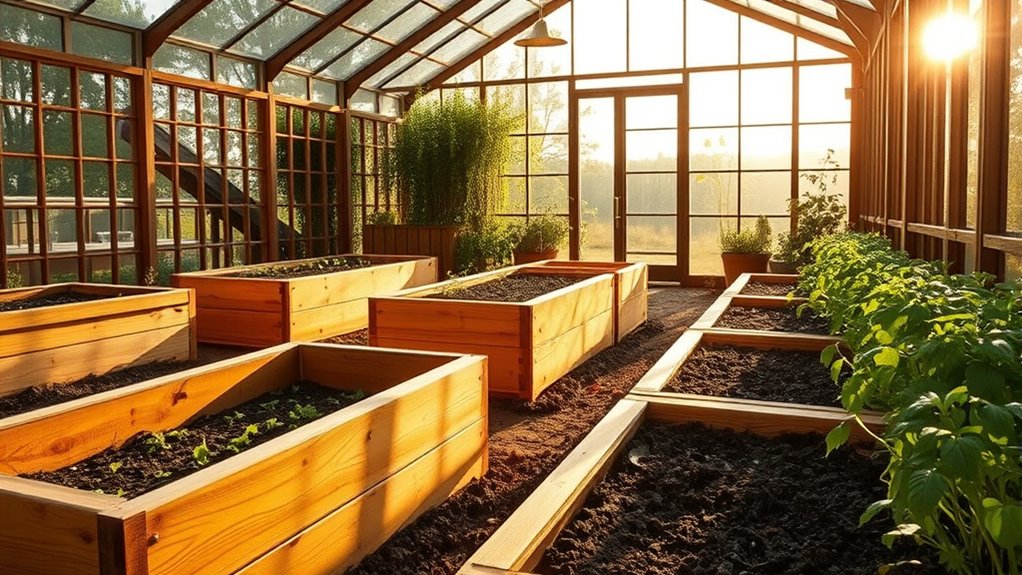
When constructing raised beds, choosing the right materials is essential for durability and functionality.
You’ll want to take into account ideal size and height to guarantee easy access and effective plant growth.
Finally, securing structural stability will help your beds withstand the test of time and support healthy plants.
Selecting Appropriate Materials
Selecting the right materials for your raised beds can greatly influence both their durability and functionality.
Wood, particularly cedar and redwood, offers natural resistance to decay, though it may eventually rot. Metal options like galvanized steel and aluminum promise long-lasting durability and a sleek look.
If you want minimal maintenance, consider composite materials that combine wood fibers and plastic. Recycled plastic is another eco-friendly choice, resistant to weathering and available in various styles.
For a rustic charm, stone provides incredible durability but can be pricey.
Evaluate your budget, aesthetic preferences, and sustainability concerns to choose the best materials for your greenhouse raised beds. Each option has its strengths, so pick what suits your garden vision best. Additionally, selecting materials that attract pollinators can enhance the overall health of your greenhouse ecosystem.
Optimal Size and Height
The ideal size and height of your raised beds can greatly enhance your gardening experience in a greenhouse. Aim for widths between 18 inches and 4 feet—wider beds, accessible from all sides, maximize plant rows while maintaining easy reach.
If your bed’s against a wall, keep it to 2 to 3 feet wide. Length should range from 4 to 10 feet, considering material sizes and structural support.
For height, a minimum of 6 inches is essential, with 12 inches being standard for most vegetables. If you’re growing deep-rooting plants, opt for beds 18 to 36 inches high to accommodate their needs comfortably and reduce back strain during maintenance.
Ensuring Structural Stability
Ensuring your raised beds are structurally stable is essential for a successful greenhouse garden. Choose materials wisely—rot-resistant woods like cedar, durable steel, or sturdy stone can provide lasting support. Reinforce corners with 2×2 lumber and add cross-supports for taller beds to prevent collapse.
| Material | Benefits | Considerations |
|---|---|---|
| Wooden | Natural look, easy to build | Prone to rot without treatment |
| Steel | High durability | Requires rust protection |
| Concrete | Maximum stability | Labor-intensive to install |
| Stone/Brick | Exceptional longevity | Can be expensive |
Regular inspections and proper drainage systems will help maintain stability. With these strategies, your raised beds will thrive in your greenhouse environment. Additionally, ensuring adequate water sources for your plants will promote healthier growth and stability in your raised beds.
Optimizing Soil Composition for Plant Growth
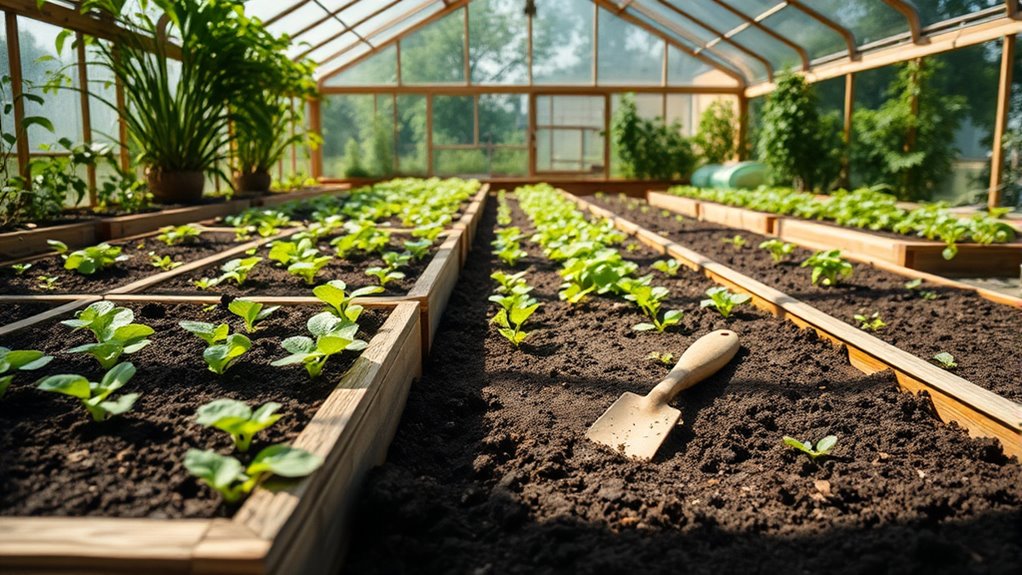
To cultivate thriving plants in your raised beds, enhancing soil composition is vital. Start with a mix of topsoil, compost, and organic matter, aiming for 25% to 50% organic content.
Test your soil’s pH to verify it falls between 6.2 and 6.8, which most plants prefer. Incorporate high-quality compost for nutrient richness and consider using Mel’s Mix, which combines peat moss, vermiculite, and compost for excellent drainage.
Tailor your soil mix to meet the specific needs of your plants and local conditions. Remember, well-draining soil is essential to prevent root rot, so focus on enhancing soil structure with organic additions. Engaging in soil health practices can also improve biodiversity in your garden and contribute to a sustainable ecosystem.
Regular testing will help maintain ideal nutrient levels for healthy growth.
Maintaining Your Raised Beds for Optimal Health
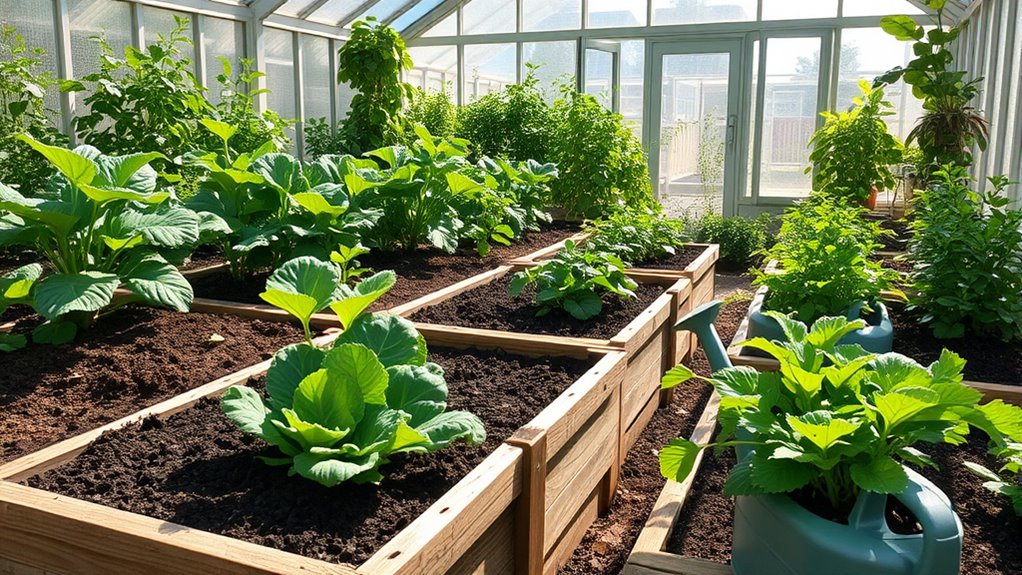
While maintaining your raised beds might seem like a chore, regular care is vital for guaranteeing ideal plant health and productivity.
Start by removing fallen leaves, weeds, and dead plants to keep your beds tidy and reduce pest risks. Inspect your raised bed structure for any signs of rot or damage, replacing compromised materials as needed. Regularly tighten loose screws and make sure the foundation is stable and well-drained.
Weed management is essential—pull weeds often and use organic mulch to suppress their growth while retaining moisture.
Water your plants at the base, checking soil moisture frequently. Finally, keep an eye out for pests, introducing natural predators when necessary, and promptly address any signs of disease to maintain crop health.
Integrating Raised Beds With Greenhouse Conditions
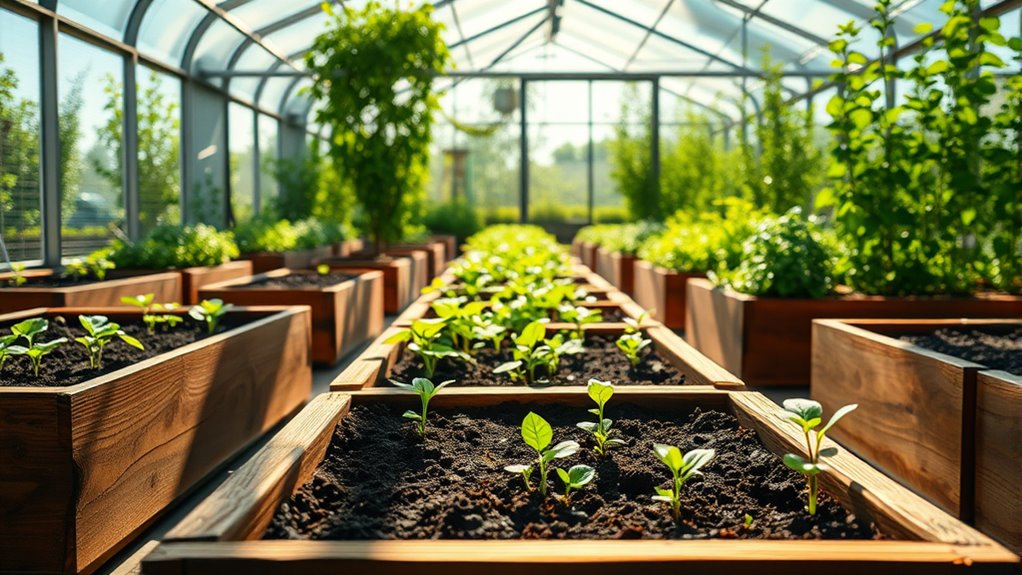
Integrating raised beds into your greenhouse not only optimizes space but also enhances overall plant health.
Keep your beds no wider than 2 feet for single-sided access or 4 feet for both sides to guarantee easy reach. Use materials like wood or plastic for their thermal benefits, and fill the beds with a mix of compost, topsoil, and peat to promote healthy growth.
Position your beds for maximum sunlight and guarantee proper ventilation to control temperature and humidity levels. Incorporate efficient irrigation systems to enhance water management, and consider using vertical space for additional crops.
Frequently Asked Questions
How Much Sunlight Do Raised Beds Require in a Greenhouse?
Raised beds typically require at least six hours of direct sunlight each day for ideal plant growth. This sunlight fuels photosynthesis, essential for developing healthy plants.
You’ll want to make sure your raised beds are positioned to capture this sunlight effectively. If you notice any shading issues, consider using shading nets or selecting taller plants to manage exposure.
Can I Use Recycled Materials for Constructing Raised Beds?
Yes, you can definitely use recycled materials for constructing raised beds! Materials like wood pallets, old bathtubs, or concrete blocks are great options.
Just be cautious about toxicity; avoid using old tires or railroad ties due to chemical leaching. Make certain to check for durability and proper drainage to guarantee your plants thrive.
What Plants Grow Best in Raised Beds Within Greenhouses?
So, you think you can just toss any plant into a raised bed and hope for the best?
Let’s be real! If you want a thriving garden, go for leafy greens like lettuce and kale, which love cooler temps.
Root veggies like carrots and beets will thrive with the right soil depth.
Fruiting plants? Give tomatoes and peppers a shot.
With the right choices, your raised beds will be the envy of the greenhouse!
How Do I Prevent Weeds in My Raised Beds?
To prevent weeds in your raised beds, start by clearing any existing weeds and using deep soil to discourage seed germination.
Layer cardboard or newspaper at the bottom for added suppression. Apply a thick layer of organic mulch, like straw or wood chips, to block sunlight.
Plant densely, using quick-growing crops to outcompete weeds. Regularly inspect for any weeds and remove them promptly to keep your beds thriving and weed-free.
What Is the Ideal Height for Raised Beds in a Greenhouse?
Imagine you’re planting tomatoes in a raised bed. The ideal height for your raised beds generally ranges from 12 to 18 inches, accommodating most vegetable crops.
If you’re growing deeper-rooted plants, consider going even higher—up to 24 inches. This height not only promotes healthy root growth but also eases maintenance.
Conclusion
Incorporating raised beds in your greenhouse isn’t just about aesthetics; it’s like giving your plants a cozy apartment. Just like you’d furnish your living space for comfort and functionality, nurturing your plants in well-designed beds can lead to bountiful harvests. Studies show that raised beds can increase yields by up to 20%. So, roll up your sleeves, get creative, and watch your greenhouse transform into a thriving oasis for your green companions. Happy gardening!
